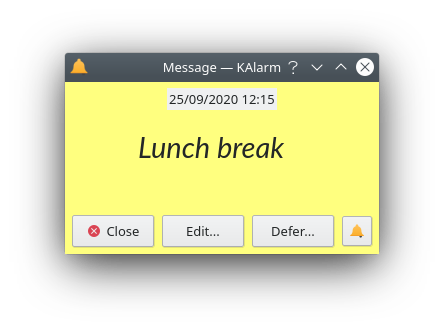KAlarm lets you schedule the display of personal alarm messages, the playing of sound files, the execution of commands and the sending of emails.
KAlarm displays the list of pending alarms, showing their times and details. You can create new alarms, or you can select existing alarms for modification or deletion. You can also optionally view expired alarms.
When configuring an alarm, you can choose whether it should repeat, and whether the alarm should be canceled if it cannot be triggered at its scheduled time. For display alarms, you can type in a message text, specify a text or image file to display, or specify a command whose output should be displayed. You can also choose the color of the alarm message, and whether to play a sound or speak the message.
Alarms may also be scheduled from the command line, or via D-Bus calls from programs.
When an alarm message is due, it is displayed on each desktop to ensure that you don't miss it. The message window shows the time for which the alarm was scheduled. It usually has a defer option to ask for the alarm to be displayed again later. An example of an alarm message:

Optionally, an alarm message may be displayed as a notification instead of in a window.
When the alarm specifies a command to execute or an email to send, KAlarm displays nothing.
KAlarm usually shows an icon in the system tray, although this can be hidden if desired.